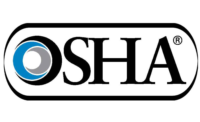Regardless of where you work and how many employees the company has, the environment almost certainly has visual cues that help people spot and avoid dangerous things. That's because OSHA provides approved colors to use around workplaces to designate hazards. Learning about them could help you bring more visual organization to an area and keep workers safer.
The basics of OSHA colors
OSHA standards include a safety color code that dictates which hues associate with possible dangers. The specifics are as follows:
- Red: Used for fire protection equipment as well as any danger signs. Also intended for portable containers — other than shipping containers — filled with flammable liquids. Such receptacles must also include a yellow band around them or the name of the contents painted in yellow. Any stop bars or buttons on hazardous machinery are also red. Red lights warn people of barricades or temporary obstructions.
- Yellow: Meant to mark physical hazards and urge caution. This color makes people aware of dangers that could cause them to slip, trip, fall, become struck with an object or get caught between something.
- Orange: This is a color OSHA discusses regarding accident prevention tags, although the information constitutes recommendations rather than mandates. Solely or predominantly orange tags with complementing details in a contrasting color get used for general warning tags, while fluorescent orange or orange-red labels are for biological hazards.
Apply safety paint to mark floors and aisles
If your workplace includes a warehouse that frequently uses moving, heavy equipment, relying on safety paint to mark aisles and safe clearance areas is an ideal step to take. OSHA guidelines about floor markings say that they should be no less than two inches wide when used to show aisle locations. Many companies opt to paint floor markings up to six inches wide or more to further increase visibility.
Consider using safety paint to guide machine operators as they maneuver machines. For example, a yellow line on a concrete floor could remind someone to be careful to avoid hitting a shelf while driving a piece of equipment. Information from OSHA mentions marking warehouse aisles to 36 inches wide, allowing for ample passage for heavy machinery.
Statistics indicate that five out of every 100 warehouse workers suffer occupation-related injuries annually. Putting safety paint on floors — whether in warehouses or elsewhere — should help employees stay oriented while on the job and visually detect things that could cause harm.
Include color awareness in safety training sessions
It's essential that any training for your employees includes coverage of the color-related specifics mentioned above. As of January 17, 2017, OSHA updated its standards for walking-working surfaces and fall prevention. Many of the new material relates to the equipment that workers wear to avoid injuries sustained after falling from heights.
However, the newest standards bring up how any workers who are at risk of encountering fall hazards receive relevant training to help them stay safe. So, your instructional content might give a reminder of how people should be especially aware of the color yellow as they move around the workplace. If the environment also includes textured flooring or mats to give better traction, let workers know to watch out for surface changes as well as the color.
Consider adding an element of visual literacy to safety training, too. It relates to how people extract meaning from the things they see. Various organizations are working together to provide visual literacy education to workers. The unconventional training takes participants to an art museum where they learn to identify and address visual biases.
A white paper about this initiative indicated that 225 workers applied their visual literacy training to find 132 potential hazards. More than two dozen of those got fixed through an internal program designed to remedy reported problems.
Reminders help enhance safety
You don't necessarily need to take employees to an art gallery to teach visual literacy. But talking to members of the workforce about how colors relate to visual organization is essential.
The good thing is that most people around the world already interpret red, yellow and orange as colors that urge them to pay extra attention, and perhaps behave in certain ways. After all, kids learn that red means stop in preschool and take that knowledge with them for the rest of their lives.
Information about safety colors likely won't tell employees things they've never heard before. But, periodic reminders are excellent for helping workers maintain a heightened awareness of things in the workplace that could harm them as well as encourage them to demonstrate an attitude of carefulness and set good examples for their colleagues.




